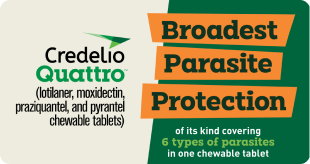Our feline companions may usually acquire worms through several ways. The most common method of worm transmission in adult cats is through ingestion of eggs from contact with infected feces. Tapeworms may be contracted through ingestion of fleas or through hunting and killing of wildlife or rodents. Hookworms may be transmitted through the skin by coming into contact with hookworm larvae in the environment. Pregnant and nursing cats may also transmit roundworms and hookworms through the placenta or milk to kittens.
Types of worms found in cats and kittens
Symptoms of worms in cats may cause any or all of the following symptoms: diarrhea (sometimes with blood), weight loss, changes in coat and general appearance, and vomiting, sometimes even with worms in the vomit, as seen occasionally with roundworms. In some cases, few or no clinical signs are seen.
Roundworms
These are probably the most common worms seen in cats. A large percentage of kittens are born with roundworm larvae in their tissues, which is transferred from the mother across the placenta. Roundworm larvae may also be transmitted to nursing kittens from the mother's milk. Adult worms develop and mature in the intestinal tract, and may pass eggs through the stool, which may reinfest other cats that come into contact with the stool. When worm eggs hatch inside your cat, young roundworm larvae are released internally and migrate to the lungs. Kittens with active roundworms in the intestines often have a potbellied appearance and don't grow as well as non-infected kittens. In rare and severe cases, intestinal blockages may occur. In adult cats, the roundworm larvae can encyst in the body tissues, and remain dormant for periods of time, later becoming activated during periods of stress or pregnancy. Most common wormers for roundworms only work on the adult parasites in the digestive tract.
Tapeworms
Tapeworms are fairly common in juvenile and adult cats, and are typically transmitted to cats that ingest fleas and cats that like to hunt and eat wildlife and rodents. Tapeworms can reach up to six inches in the digestive tract and often have as many as 90 segments, which often may be seen in the stool or around the rectum of infected cats. This is the most common way that tapeworms are diagnosed. In most cases, tapeworms cause very few clinical signs in affected pets, with mild illness and weight loss the most common symptoms.
Hookworms
Although more common in dogs, hookworm infections do occur in cats. These blood sucking parasites are often found in the small intestine of infected animals. Hookworms may be transmitted in the uterus of infected pregnant dogs, as well as through contact with the larvae in stool contaminated soil, or from ingesting the eggs. Hookworms are also transmitted through the milk to nursing kittens. Hookworms most commonly cause diarrhea, which may be bloody, as well as causing severe anemia in heavily infested kittens.
How to deworm your cat
Worming schedules will vary depending on the age of your cat and type of worm identified. Kittens are usually wormed at six weeks of age, with further treatments every three weeks until they are four months old. A broad acting wormer such as Drontal, which is often effective against hookworms and roundworms common in kittens of this age, is often used. For cats with tapeworms, Praziquantel is the most common medicine given. This drug can be found in Droncit, Drontal, Tape Worm Tabs for Cats, and Profender Cat Wormer, and can be repeated a second time in three weeks. Heartworm prevention medications such as Revolution also prevent hookworms and roundworms,
3.8 out of 5 Customer Rating
Prescription Item
35% off first AutoShip
Code: SAVE35
$6.17
3.8 out of 5 Customer Rating
Shop now
3.9 out of 5 Customer Rating
35% off first AutoShip
Code: SAVE35
$17.98
3.9 out of 5 Customer Rating
Shop now
5 out of 5 Customer Rating
Prescription Item
35% off first AutoShip
Code: SAVE35
$16.08
5 out of 5 Customer Rating
Shop now
4.2 out of 5 Customer Rating
Prescription Item
$189.18
4.2 out of 5 Customer Rating
Shop now
5 out of 5 Customer Rating
35% off first AutoShip
Code: SAVE35
$5.47
5 out of 5 Customer Rating
Shop now
Consult your veterinarian
Cat owners should always consult with their veterinarian before giving their cats any over-the-counter worming medication. If tapeworms are present, most over-the-counter wormers are not effective, so it is best to consult with your veterinarian when trying to rid your cat of tapeworms.




















































